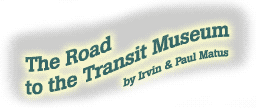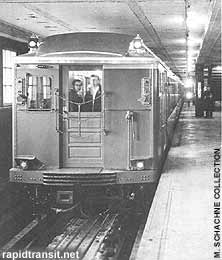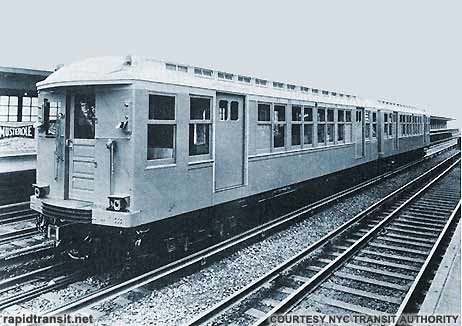

Page 6
Fast cars, they were structurally superior, with floors specially built by Pressed Steel Car Co. and steel side posts, a combination providing rigidity without turnbuckles.
The Coney Island Shops, the most complete traction shop facility ever assembled, took the design and produced an outstanding result. The cars that came off the assembly line had a metal shell where there had been a platform while four windows per side were surrendered to neat little MU doors (unlike the ugly outside assembly used on the "C's", the doors of the '39 conversion slid into pockets). In a startling coat of orange and blue paint, with gleaming silver roofs, the last BMT designed car went into service - the Q (Queens)-types. People who rode the rapid to the World's Fair of 1939 never forgot the speedy beauties which plied the way to the "World of Tomorrow"

Enter the "Q's"
Gove was determined to improve on the concept of "L" car modernization embodied in the C-types for the BMT's World's Fair fleet. He hauled 67 1200 and 49 1400 series gate cars down to Coney Island shops for rebuilding.
As a choice for rebuilding, Gove couldn't have chosen a better design than the 1200-1400 series "L" cars, advanced unit built at the end of the elevated car era. Look-alikes built in 1903 and 1907, the 1200 and 1400 cars were the product of a split order divided among Bradley (35 cars), Brill (25), and Laconia (40) in 1903, and Laconia and Jewett for the 1400's in 1907.
Fresh and bright, a train of Q-types gathers fairgoers at Queensboro Plaza. The picture appears to be underground as the lower level platform shown here was enclosed although the entire station is actually elevated.
In the event the reader is at a loss to understand in what way this neat little progression of events connects to a transit museum in the ending decades of the 20th century, we must jump forward a quarter of a century from the 1939-'40 World's Fair to the next World's Fair in New York, that of 1964-'65.
In both Fairs, many millions arrived on the City's rapid transit system. The NYCTA's desire to have a "Transit Day" in celebration of the '65 edition of the Fair provided a unique opportunity to form the nucleus of an official New York City transit museum.
A TA museum had been a long time source of discussion. Finally, early in 1965, the New York Times ran a feature on it, which seemed to indicate that it was moving out of the netherworld relegated to the weather and incumbent Southern Democrats.

The Trail of the "Q's": Sparkling on the Flushing Line, a freshly outshopped unit poses proudly.
Updated
©1966 Silver Leaf Rapid Transit. ©2000 The Composing Stack Inc. All right reserved